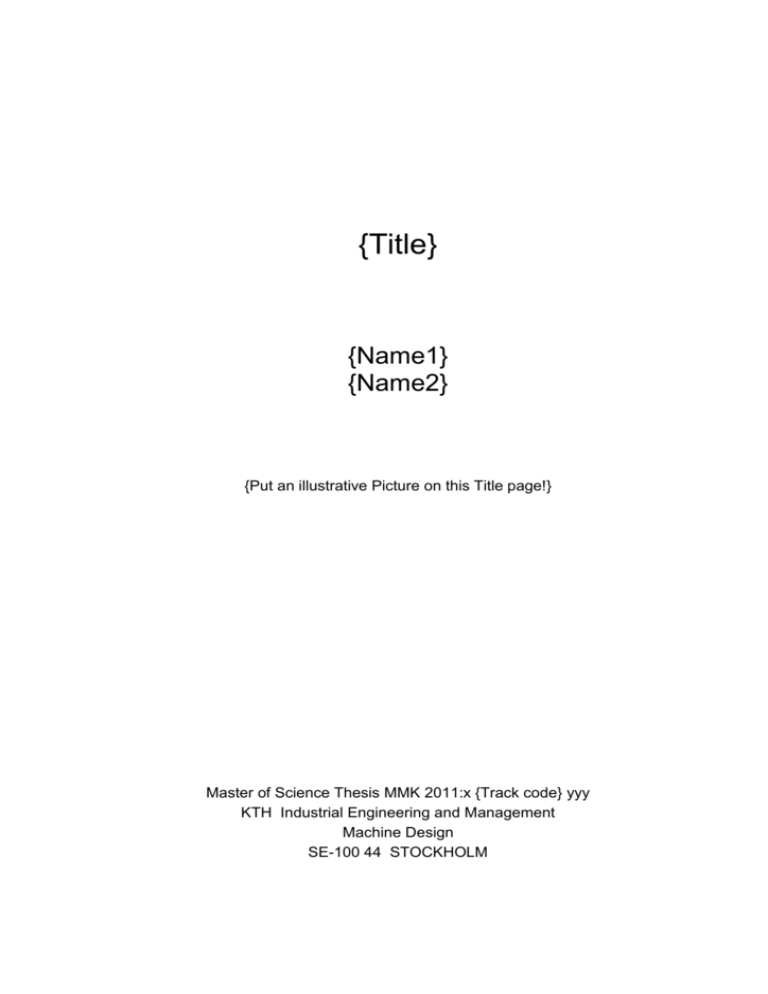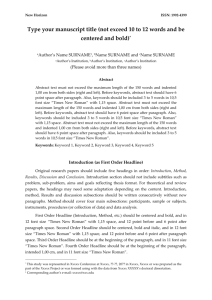7 references
advertisement

{Title}
{Name1}
{Name2}
{Put an illustrative Picture on this Title page!}
Master of Science Thesis MMK 2011:x {Track code} yyy
KTH Industrial Engineering and Management
Machine Design
SE-100 44 STOCKHOLM
Examensarbete MMK 2011:x {Track code} yyy
{Rapporttitel}
{Namn1}
{Namn2}
Godkänt
Examinator
Handledare
2011-mån-dag
{Namn}
{Namn}
Uppdragsgivare
Kontaktperson
{Namn}
{Namn}
Sammanfattning
Examensarbetet skrivs på svenska eller engelska och har alltid både en svensk och en engelsk
sammanfattningssida. Ett arbete om skrivs på svenska har ett svenskt Omslag och en svensk
Titelsida. Denna skrivmall, som inte har “bookmarks” eller några avancerade “features”,
definierar layouten för ett examensarbete i maskinkonstruktion (MF206X) men är även
tillämpbar för andra examensarbeten på institutionen för maskinkonstruktion. Den
kapitelstruktur, som presenteras här, är inte obligatorisk utan skall enbart ses som ett exempel på
en sådan.
I detta kapitel sammanfattas examensarbetet. Sammanfattningens omfattning är högst en sida.
Typsnittet är Times New Roman 12 pt, med 6 pt före med raka vänster- och högerkanter.
Sammanfattningen åtföljs av en blank sida. Den föregående titelsidan, som lämpligen också
innehåller en illustrativ bild, följs också av en blank sida. Alla kapitel börjar längst upp på en
högersida, dvs på ett udda sidonummer.
1
2
Master of Science Thesis MMK 2008:x {Track code} yyy
{Title}
{Name1}
{Name2}
Approved
Examiner
Supervisor
2008-month-day
{Name}
{Name}
Commissioner
Contact person
{Name}
{Name}
Abstract
The thesis is written in Swedish or English and it has both a Swedish and an English Abstract
page. An English thesis has English Cover and Title pages. A Swedish thesis has Swedish Cover
and Title pages. This template, which has no bookmarks or other automation features, defines the
layout of a masters thesis in machine design (MF206X), but it also applies to other masters
theses at the department of machine design. The chapter structure that is presented here is not
mandatory, it is just an example.
The abstract is maximum one page long and it is written in Times New Roman 12 pt, with 6 pt
before, justified alignment. The abstract page is followed by a blank page. The preceding title
page, which preferably contains an illustrative picture, is also followed by a blank page. All
chapters start at the top of a right hand page, i.e. a page with an odd number.
3
4
FOREWORD
Use 12 pt Times New Roman, Italic and 6 pt before and 12 pt after, to describe the content of
this chapter in two or three justified rows.
Here is the right place to acknowledge help, assistance, cooperation and inspiration important for
the presented project provided by others. This section, which is optional, should be written in
Times New Roman, 12 pt and 6 pt before, with justified alignment. Please, leave two empty
rows before the body text.
The foreword chapter should be ended with the two rows Name(s), and Place and month written
in Times New Roman 12 pt, and right adjusted. Name(s) should be 36 pt before and Place,
month and year should be 12 pt before.
Name(s)
Place, month and year
5
6
NOMENCLATURE
Use 12 pt Times New Roman, Italic and 6 pt before and 12 pt after, to describe the content of
this chapter in two or three justified rows, e.g. Here are the Notations and Abbreviations that are
used in this Master thesis. (Only include the lists that are applicable). The lists are written in 12
pt Times New Roman, 6 pt before.
Notations
Symbol
Description
E
Young´s modulus (Pa)
r
Radius (m)
t
Thickness (m)
…..
…….
Abbreviations
CAD
Computer Aided Design
CAE
Computer Aided Engineering
PLM
…
Product Lifecycle Management
…
7
TABLE OF CONTENTS
SAMMANFATTNING (SWEDISH)
1
ABSTRACT
3
FOREWORD
5
NOMENCLATURE
7
TABLE OF CONTENTS
9
1
INTRODUCTION
11
1.1 Background
11
1.2 Purpose
11
1.3 Delimitations
12
1.4 Method
12
2
FRAME OF REFERENCE
13
3
IMPLEMENTATION
15
4
RESULTS
17
5
DISCUSSION AND CONCLUSIONS
19
5.1 Discussion
19
5.2 Conclusions
19
RECOMMENDATIONS AND FUTURE WORK
21
6.1 Recommendation
21
6.2 Future work
21
REFERENCES
23
6
7
APPENDIX A: SUPPLEMENTARY INFORMATION
8
25
9
1 INTRODUCTION
Use 12 pt Times New Roman, Italic and 6 pt before and 12 pt after, to describe the content of
this chapter in two or three justified rows, e.g. this chapter describes the background, the
purpose, the limitations and the method(s) used in the presented project.
1.1 Background
The main heading is numbered and typed Right aligned in Bold Arial. The main heading font
size is 18 pt, with 12 pt before and 12 pt after. Second level headings, e.g. “1.1 Background” are
left aligned and typed in 16 pt Bold Italic Arial, with 24 pt before and 6 pt after.
The body text is typed in Times New Roman, 12 pt, 6 pt before, and justified.
1.2 Purpose
Figures in the thesis should be centered on the page with 12 pt space before. The figure legends
should be in 10 pt regular Times New Roman, centered with a 12 pt space before and 6 pt after.
The figures should be numbered Figure 1, Figure 2, etc.
Figure 1. The ITM logo, from ITM (2011).
The table headers should be in 10 pt regular Times New Roman, centred with a 12 pt space
before and a 12 pt space after. The tables should be numbered Table 1, Table 2, etc. Text in
tables should be in 12 pt regular Times New Roman,centred, 0 pt before and after. An example
of a table with a heading is shown below.
Table 1. Table header
Row 1, column 1
Row 2, column 1
…..
Row n, column 1
Row 1, column 2
Row 2, column 2
….
Row n, column 2
Unnumbered lists should preferably use a dot as a bullet, and should be in 12 pt Times New
New Roman, justified, 6 pt before, with 1 cm hanging indent and 1 cm tabs.
1.
Numbered lists should be numbered 1,2,3 etc., and should be in 12 pt Times New Roman,
justified, 6 pt before, with 1 cm hanging indent and 1 cm tabs.
10
Equations should be centered, 12 pt before. Each equation should be numbered consecutively
throughout the paper using Arabic numbers in parenthesis: (1), (2), etc. The equation number
should be right shifted and enclosed within parenthesis.
U=R⋅I
(1)
References to published work should be done using Name and year. For example, Angell and
Straub (1999) states that …, or non-linear finite element analysis requires extensive skill
(Crisfield, 1997). Please, observe the small distinction between references to Journals (van
Wezel and Jorna, 2001) and (Angell and Straub, 1999), a published book (Crisfield, 1997) and a
conference proceeding (Eppinger and Salminen, 2001). Standish Group (1994) is an example of
a reference from the Internet. The reference heading is a regular chapter heading. Each reference
item should be in 12 pt Times New Roman, justified with 6 pt space before.
1.3 Delimitations
It is good practice to define and describe limitations of the project/task in the introductory
chapter.
1.4 Method
The method(s) used to address the problem defined above may either be defined in the
introductory chapter or elaborated on more in detail in a following chapter.
11
2 FRAME OF REFERENCE
The reference frame is a summary of the existing knowledge and former performed research on
the subject. This chapter presents the theoretical reference frame that is necessary for the
performed research, design or product development.
12
13
3 IMPLEMENTATION
In this chapter the working process is described. A structured process is often called a method
and its purpose is to help the researcher/developer/designer to reach the goals for the project.
The actual title of this chapter depends on the scope and context of the specific project, that is it
may be “3 Concept development” with subparagraphs such as “3.1 Requirements
specification”, “3.2 Concept generation”, etc. for a project with that scope or it may be “3
Method” for a more traditional research study.
14
15
4 RESULTS
In the results chapter the results that are obtained with the process/methods described in the
previous chapter are compiled, and analyzed and compared with the existing knowledge and/or
theory presented in the frame of reference chapter.
16
17
5 DISCUSSION AND CONCLUSIONS
A discussion of the results and the conclusions that the authors have drawn during the Master of
Science thesis are presented in this chapter. The conclusions are based from the analysis with
the intention to answer the formulation of questions that is presented in Chapter 1.
5.1 Discussion
The main heading is numbered and typed Right aligned in Bold Arial. The main heading font
size is 18 pt, with 12 pt before and 6 pt after. Second level headings, e.g. “5.1 Discussion” are
left aligned and typed in 16 pt Arial Bold Italic, with 24 pt before and 6 pt after.
The body text is typed in Times New Roman, 12 pt, 6 pt before, and justified.
5.2 Conclusions
The second level headings 5.2 Conclusions is left aligned and typed in 16 pt Bold Italic, with 24
pt before and 6 pt after.
The body text is typed in Times New Roman, 12 pt, 6 pt before, and justified.
18
19
6 RECOMMENDATIONS AND FUTURE WORK
In this chapter, recommendations on more detailed solutions and/or future work in this field are
presented.
6.1 Recommendations
The main heading is numbered and typed Right aligned in Bold Arial. The main heading font
size is 18 pt, with 12 pt before and 6 pt after. Second level headings, e.g. “6.1
Recommendations” are left aligned and typed in 16 pt Bold Italic, with 24 pt before and 6 pt
after.
The body text is typed in Times New Roman, 12 pt, 6 pt before, and justified.
6.2 Future work
The main heading is numbered and typed Right aligned in Bold Arial. The main heading font
size is 18 pt, with 12 pt before and 6 pt after. Second level headings, e.g. “6.2 Future work” are
left aligned and typed in 16 pt Bold Italic, with 24 pt before and 6 pt after.
The body text is typed in Times New Roman, 12 pt, 6 pt before, and justified.
20
21
7 REFERENCES
van Wezel W. and Jorna W.J., “Paradoxes in planning”, Engineering Applications of Artificial
Intelligence, Vol. 14, 2001, pp 269-286.
Angell I.O. and Straub B., “Rain-Dancing with Pseudo-Science”, Cognition, Technology &
Work, Vol. 1, 1999, pp 179-196.
Crisfield M.A., “Non-linear Finite Element Analysis of Solids and Structures. Volume 2:
Advanced Topics”, John Wiley & Sons, Chichester, 1997.
Eppinger S.D. and Salminen V.K., “Patterns of product development interactions”, Proceedings
of ICED ’01, Vol. 1, Glasgow, 2001, pp 283-290.
ITM, “KTH Industrial engineering and management”, http://www.kth.se/itm, accessed 2011-0825.
Standish Group, “Chaos: Chartering the Seas of Information Technology”,
http://www3.uta.edu/faculty/reyes/teaching/general_presentation/chaos1994.pdf, accessed 200710-19, 1994.
.
22
23
APPENDIX A: SUPPLEMENTARY INFORMATION
The appendix or appendices is the natural place for detailed or supplementary information that
would make the thesis less easy to read if they were given in the previous chapter. Please, give
each appendix a suitable title.
24
